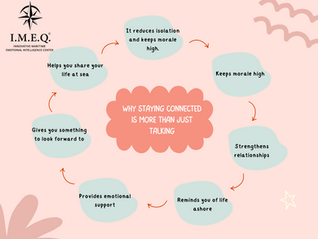Seafaring and Depression
- IMEQ CENTER

- Feb 8, 2017
- 5 min read
Updated: May 31, 2021

Seafaring is not an occupation without risks. One might actually say the opposite; there are many dangers and potential health hazards for seafarers and the mortality rates for seafarers is rather high. Seafaring is a physically demanding and taxing occupation where working long hours with little sleep is often the norm, which can potentially lead to burnout and fatigue. Seafarer’s have to face the possibility of workplace accidents, which can often be lethal, especially since getting access to medical care at sea can be challenging, as well as being victims of piracy and all the dangers that entails. Additionally, seafarers are at risk of cardiovascular diseases and cancers due to work – related conditions and if their diet is poor and they use cigarettes or alcohol as coping mechanisms. Aside from the clear health risks, the life of a seafarer can be an isolated one. Seafarers spend most of their time traveling at sea, away from their families, friends and homes. This separation can last from days to even years and it can be emotionally taxing for both the seafarers and their families and loved ones.
All the above are factors that are associated with depression, which is prevalent among seafarers. Moreover, among seafarers with depression there is a high risk of suicide, with seafarers being the second highest at risk group globally, according to the World Health Organization. The mortality rate of suicides in seafarers is not standard because a lot of potential deaths are listed as disappearances at sea, so it may be even more prevalent than it is assumed. In a nutshell, depression is highly prevalent among seafarers and it can lead to suicide. But, before we examine how we can help seafarers deal with depression, we have to understand it.
What is depression?
Depression, or Major Depressive Disorder, is classified as a mood disorder. It is estimated to affect 350 million people worldwide, and it’s the leading cause of disability globally. Depression can occur at all ages groups but it’s more prevalent between the ages 18 – 29. Women report depression 1.5 – 3 times more than men do. Depression is diagnosed if combinations of the following symptoms are reported to occur nearly every day and for the biggest part of the day, either from the individual or from others regarding him/her:

Depressed mood that is defined by feelings of sadness, emptiness or hopelessness reported by the individual or others.
Lack of interest or enjoyment from activities that were once pleasurable.
Significant changes in weight and appetite, more specifically loss or gain without the individual trying to initiate the change.
Sleeping either way more or way less than normally.
Differences in movement, either moving faster and more nervously than normal or noticeably slower.
Tiredness and reported lack or energy.
Difficulty concentrating, thinking and making decisions.
Feelings of worthlessness and guilt.
Recurrent thoughts or mentions of death, suicidal ideation with or without a plan to commit.
When looking at depression, it is important to understand that not all the symptoms mentioned above need to be present to diagnose someone with depression. Depression is diagnosed if 5 of the above symptoms are present for a period of at least two weeks and one of those symptoms has to be either depressed mood or loss of pleasure. When examining the symptoms, the focus shouldn’t be one – sided (e.g. focusing on lack of sleep instead of sleeping too much and weight loss instead of weight gain) but on deviations from the norm. So, if you suspect that you or someone close to you may suffer from depression, don’t look at the individual behaviors but, instead, look at what has changed.
Before assuming that an individual suffers from depression, it has to be taken into account that depressive episodes can occur naturally in life at times of grief. loss or transition or be the result of substance abuse, which is why the symptoms need to be present for at least two weeks before looking for a diagnosis. Moreover, depression can be a result of living with another disorder, like anxiety or schizophrenia, and if there are manic episodes it might indicate Bipolar Disorder instead of depression. In cases of substance abuse it has to be examined if the individual is experiencing depression as a response to a substance or due to withdrawal or if he / she is using to cope with depression. Finally, lesser severity in the symptoms, may not indicate to depression but it can indicate to dysthymia.
These distinctions are important so it is crucial to turn to a licensed mental health professional before assuming that you or someone close to you suffers from depression.
What About Suicide?
Suicide is a constant risk during depressive episodes. More than 800.000 people commit suicide every year, making it the second leading cause of death between the ages 15 – 29. Populations at increased risk for suicide include being male, living alone, going through incredibly distressing events and suffering from depression. The biggest warning sign is past attempts or threatening suicide, with 20 – 50% of people who commit suicide having had a previous attempt.
Behaviors that indicate that someone is at risk for suicide are talking or obsessing about death, risky or life threatening behaviors like drunk driving, exhibiting symptoms of depression, particularly depressive mood and loss of interest and pleasure in activities, and commenting about being hopeless or worthless. Particular behaviors are more alarming, notably putting one’s legal and financial affairs in order, moving from visible distress to suddenly appearing calm, saying things like “it would be better if I wasn’t here” or talking about suicide and saying goodbye to people.
Treatment

Although the symptoms of depression and the suicide risks seem severe, depression is highly treatable and the treatments, when followed properly, are very effective.
The most common treatments for depression are psychotherapy and pharmacological therapy.
Psychotherapy is often considered to be the first line of defense when dealing with depression. There are various therapeutic approaches, with the most notable being cognitive – behavioral therapy, that targets the beliefs and attitudes associated with depression and encourages change. Other effective therapeutic interventions include interpersonal psychotherapy, which treats depression ad a medical disease and is most suitable to use with medication, psychodynamic psychotherapy, which is both broader and longer in duration than other interventions and targets the underlying conditions that initiated the depression and group therapy, which has shown good results, particularly through the benefits of having depressed individuals being in contact with people who face similar difficulties.
As far as medications are concerned, there is a variety of antidepressants that are effective in treating depression. The type and dosage of medication should be decided by a psychiatrist on account of the individual’s needs and history. The use of both psychotherapy and medication is shown to be the most effective in dealing with depression, especially in long – term situations.
Helping Seafarers
Aside from the standard depression treatments, steps can be taken to ensure the wellbeing of seafarers. Isolation and loneliness in seafarers are major factors in developing depression. Seafarers are separated from their families for prolonged periods of time. Ensuring means of communicating with them on a regular basis would be a major step in dealing with the issue. Access to the internet that is free and high quality so they can communicate with their loved ones would be greatly beneficial to their psychological wellbeing. Implementing shore leave would also help, since it would give seafarer’s the ability to decompress and socialize outside of the ship environment. Reducing working hours and ensuring rest, improving the occupational conditions by doing whatever possible to minimize accidents and having more accessible first aid, and reducing the time spent at sea can help improve both the physical and psychological wellbeing of seafarers and should be taken into consideration.





































































































Comments